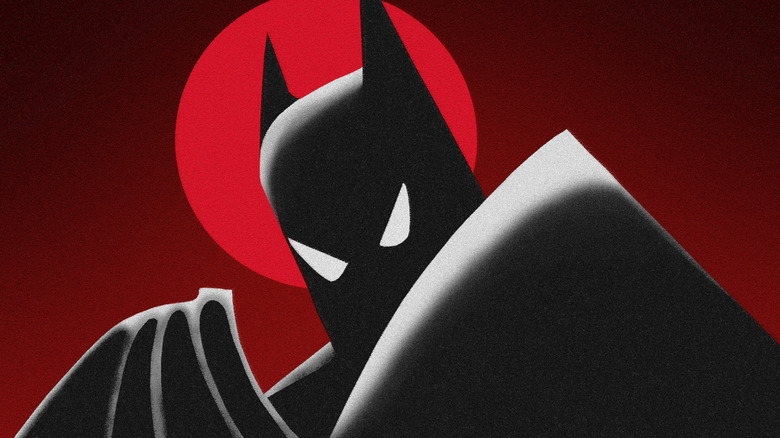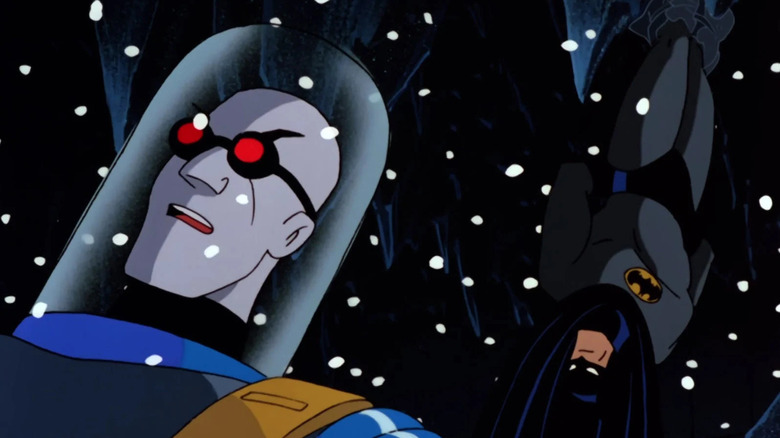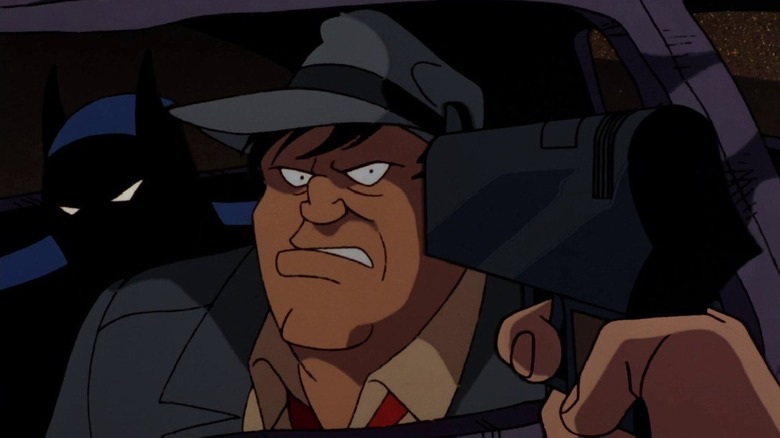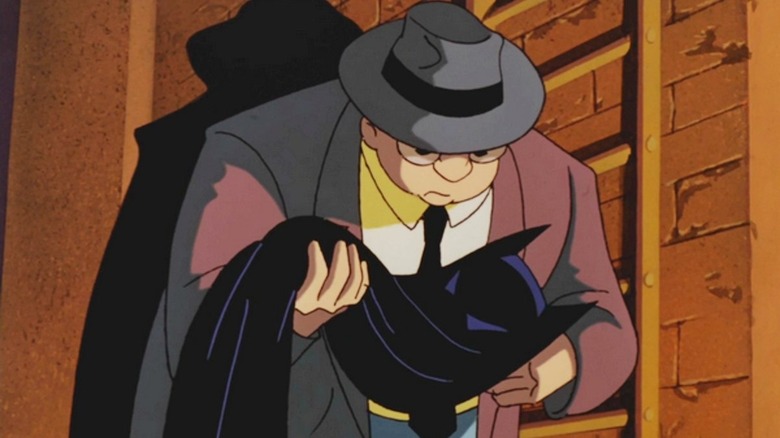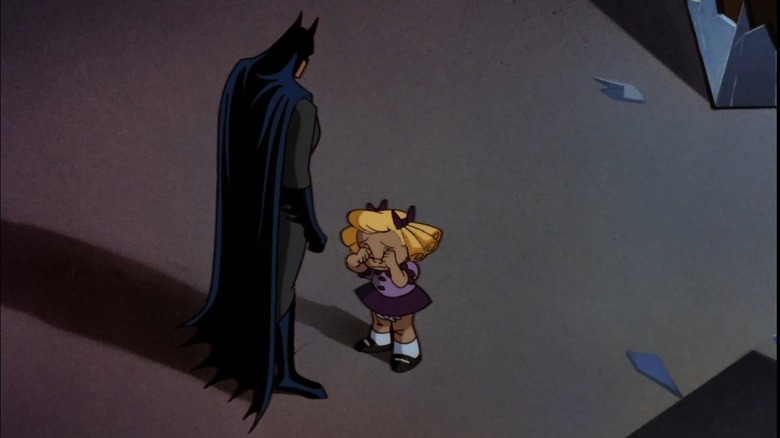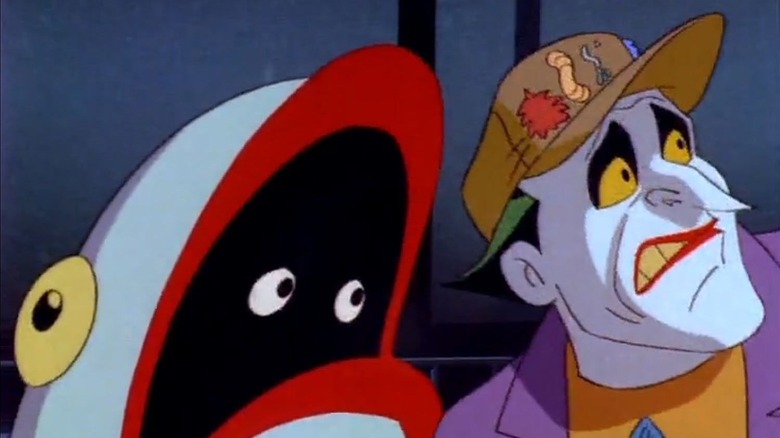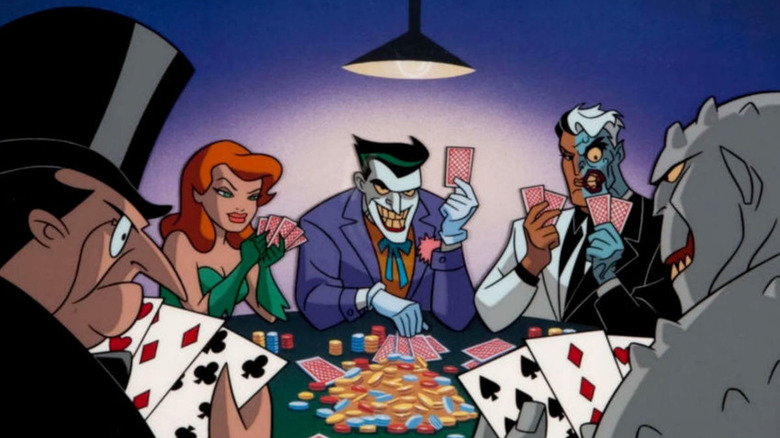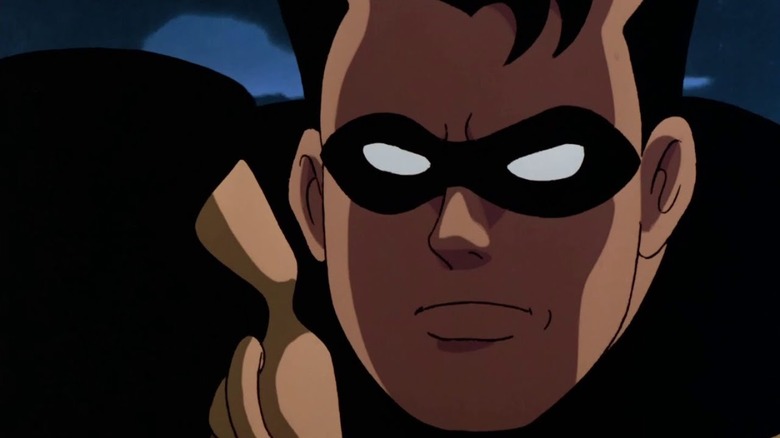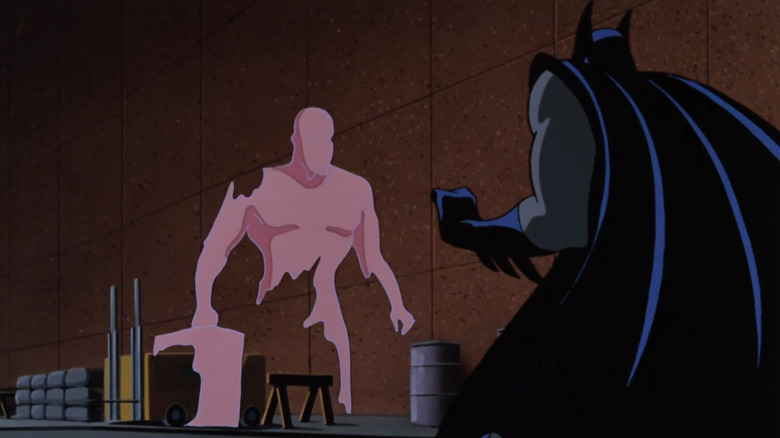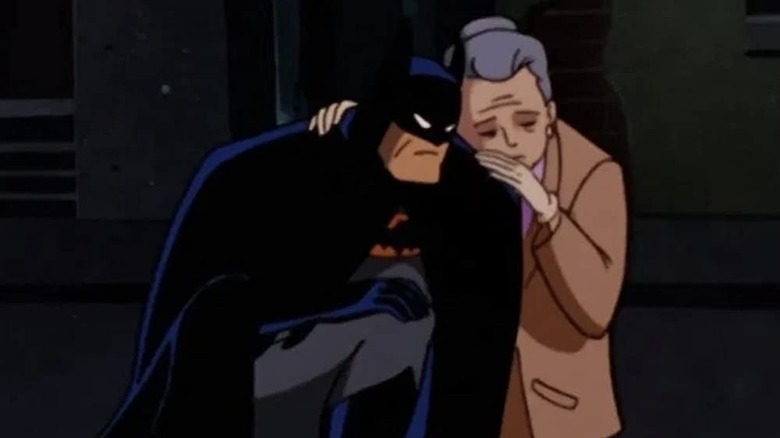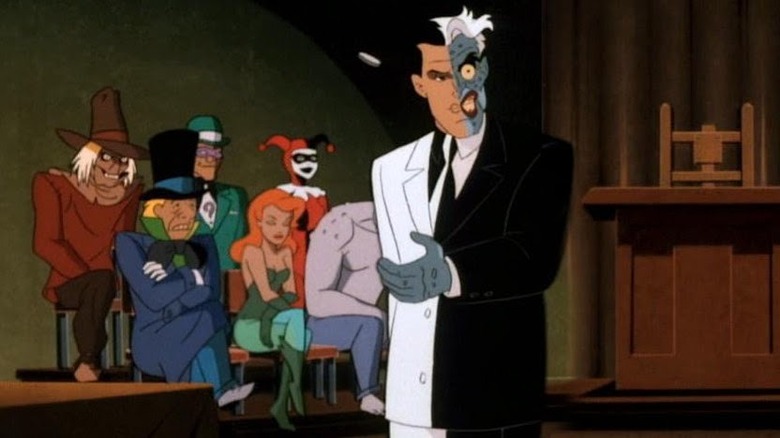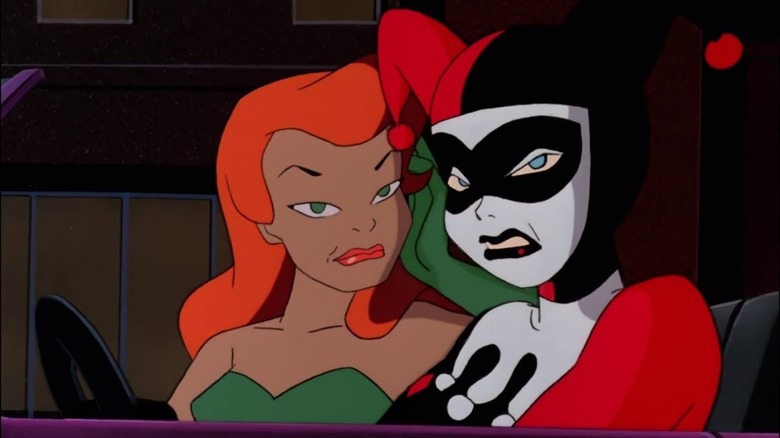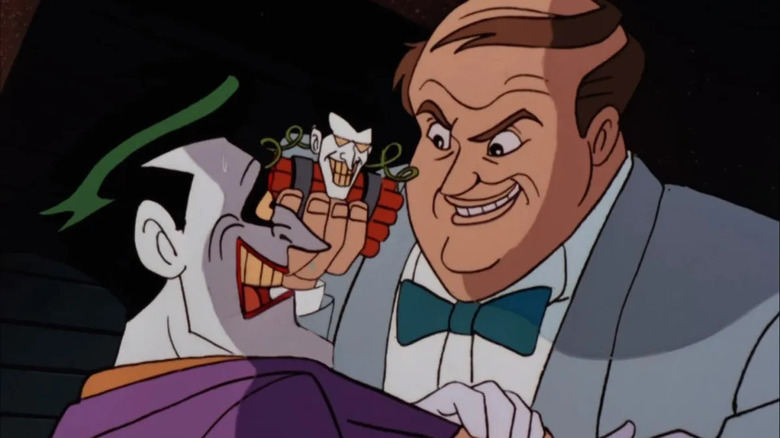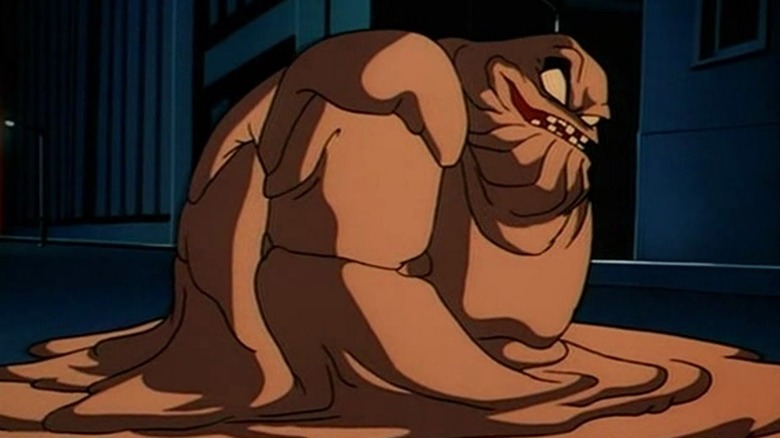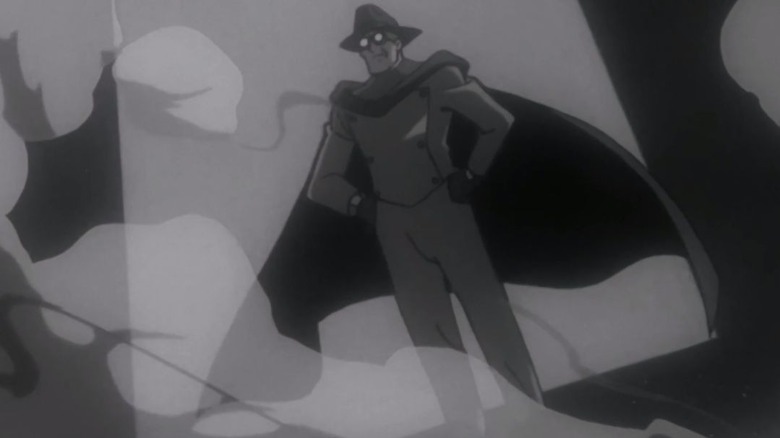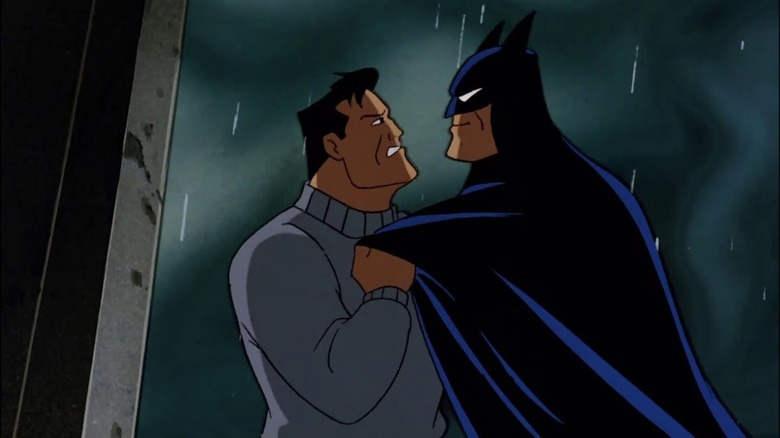The 15 Best Batman: The Animated Series Episodes
"Batman: The Animated Series" was the perfect synthesis of The Dark Knight. The seminal series, shepherded by talents like Bruce Timm, Alan Burnett, Eric Radomski, and Paul Dini, set a new standard for superhero storytelling writ large. The show's creators achieved this lofty standard by melding influences from Tim Burton's art deco Gotham, the animation of Max Fleischer's '40s "Superman" cartoons, and decades of comic book stories from across the spectrum.
The results speak for themselves. From key contributions to the Batman mythos like Mr. Freeze's tragic backstory and the debut of Harley Quinn, to defining turns from Mark Hamill as the Joker and Kevin Conroy as the Caped Crusader himself, not to mention the distinctively dark designs and expressive animation, there's a reason the 1992 series has lingered so long in the hearts and minds of fans of all ages.
As another reimagining of the Bat lurks in the wings, we're here to pay tribute to the 15 best episodes from this superlative show, which like its hero, still casts a long shadow.
15. Heart of Ice
"Heart of Ice" and its reimagined Mr. Freeze set the tone for the series' approach to its villains. Victor Fries is downright terrifying here, with his dead eyes, fishbowl-like helmet, and Michael Ansara's menacing monotone voice. But he's also a tragic figure, fighting to avenge his lost soulmate, and a victim of forces more pernicious than any one supervillain.
Those forces are embodied by Ferris Boyle, an example of the corrupt corporate snake archetype that "Batman: The Animated Series" would return to again and again. Boyle and his craven financial interests are behind both the loss of Victor's wife and his present subzero state. The smiling CEO is magnanimous in public but cruel and uncaring behind closed doors. He's an ironic counterpoint to Mr. Freeze himself, who seems cold on the surface but is passionate, even lyrical, at heart.
One of the series' best features was the complexity and grace it granted to villains like Mr. Freeze. Victor's losses earns him Batman's sympathy as well as the audience's, even when his plans wreak havoc in a futile effort at revenge. And when Batman digs up the dirt on Boyle and hands it over to the media, his choice confirms that he doesn't merely fight to stop supervillains; he fights for justice.
Honorable Mention: "Two-Face" another early triumph for the series that delves deeply into the psychology and pathos of its title character.
14. A Bullet for Bullock
There may be no greater description of Harvey Bullock than Alfred's, dubbing him "the detective who looks like an unmade bed." Robert Costanzo did superb work breathing life into the disheveled, disagreeable copper who resented Batman's presence in his city.
But the boon of "A Bullet for Bullock" is the way it finds a plausible scenario in which Batman must team up with the GCPD detective who loathes him the most. When Bullock's life is seemingly threatened by one of the crime bosses he put away, the Caped Crusader is duty-bound to help his foe on the force.
It's a great setup, which combines an amusing odd couple routine, a cool mystery plot, and clever resolutions to each. The episode underscores the personal differences that divide Batman and Bullock, while also showing the common goals that bring them together. Even late in its run, the series found new angles on familiar faces and highlighted the begrudging respect between these two very different forces for good.
13. The Man Who Killed Batman
Shoving a bumbling, third-rate goon into the spotlight for an episode is another inspired choice from "Batman: The Animated Series." Meet Sid the Squid, a low-level criminal who's half Rick Moranis and half Kermit the Frog. Sid dreams of being a bigtime underworld boss — only, when it seems he's (accidentally) taken out the Dark Knight himself, Sid gets a lot more than he bargained for.
With Paul Dini writing the script and Bruce Timm directing, "The Man Who Killed Batman" offers the best of both worlds. There's superb comedy here, from Joker's usual antics to Sid's nebbish ways. But there's also a wisp of pathos, as Joker laments that without his archenemy, "crime doesn't have a punchline," while Sid watches his aspirations run aground on reality.
The episode boasts clever turns and amusing scenes throughout. In the end, watching a minor schnook crumple under the infamy of appearing to have iced the Bat made for one of the show's most creative outings.
12. Baby Doll
Only "Batman: The Animated Series" could take a goofy story about a one-time child star kidnapping her former castmates and make it into one of the series' most heartrending installments.
Mary Louise Dahl was an adorable sitcom moppet with a condition that makes her look like a little girl even after she's grown up. Having aged on the inside, if not the outside, Mary becomes "Baby Doll," a colorful villain who mixes her childhood catchphrases with legitimate threats in a ploy to get revenge on the Cousin Oliver-esque costar who upstaged her. And yet, what Baby Doll truly wants is to return to the one period of her life when she was happy; she yearns to go back to the only time she had a family, even if it was just a TV family.
Most of Batman's villains are some shade of unwell. Most of them have been screwed over by an even more malevolent force. But what distinguishes Mary is how she's simply a poor young woman driven to the edge by unfair circumstances and a world that had no use for her once she could no longer entertain. Her tears after seeing a glimpse of the woman she might have grown into via a funhouse mirror, and Batman's impulse to help rather than punish her, mark her tale as one of the show's finest.
Honorable Mention: "Sideshow," in which Baby Doll's future partner in crime, Killer Croc, gets his own misguided chance at finding a home.
11. The Laughing Fish
What superlative hasn't already been laid at the feet of Mark Hamill's Joker? And every bit of it is earned. Never before had the character found such a perfect balance between a downright hilarious shtick and an equally terrifying menace. With a performer like Hamill and a writer like Paul Dini, the Joker reached a true high water mark in "Batman: The Animated Series."
And "The Laughing Fish" may very well be his best outing in the show. In the episode, Joker tries to copyright any smiling fish exposed to his Joker toxin in order to collect royalties. It's the kind of loony scheme only he could pull off. But what makes this one special is not just Hamill's best performance as the Clown Prince of Crime, which is genuinely funny and frightening in turn, but also the way it drives home Joker's peculiar ethos: to cause mayhem purely for comedy, not for profits.
The episode explains why Joker is so slippery in the demented cat and mouse games he plays with Batman. Joker doesn't want anything in the way other villains do. He just wants to have a laugh, no matter how deadly the consequences. And it makes him unpredictable, dangerous, and thoroughly entertaining every time.
Honorable Mention: "Joker's Wild", another fun dose of the character's antics built around efforts to monetize his likeness.
10. Almost Got 'Im
If it had been half as ambitious, "Almost Got 'Im" would still be a great episode. Forgoing the usual episode-length story in favor of a pack of villains sitting around, telling war stories, and letting the audience witness their near misses with the Bat is a fun idea all on its own. In addition, the chance to do individual vignettes allows the show's animation team, including director Eric Radomski, to go wild with each encounter recounted by Gotham's ne'er-do-wells.
But it's the added level of creativity here that puts the episode over the top. The reveal that this isn't just a swarm of villains chewing the fat over a game of poker, but instead a live situation in which Joker's scheme is still in play, makes for a brilliant hand-off from past to present.
The twist is just as good, as we learn that Batman's been masquerading as Killer Croc to find Catwoman, returning the favor after she saved him from the Joker's latest screwball plan. And Catwoman's own declaration of "Almost got 'im" makes for an amusing double entendre. "Batman: The Animated Series" was never afraid to give its villains their moment in the sun, and in this one, they all shine brightly.
9. Robin's Reckoning
What holds Bruce Wayne and Dick Grayson together is more than their familial bond; it's their shared tragedy. "Robin's Reckoning" jumps back and forth between the past, where we witness the terrible loss of Robin's parents, and the present, where the Boy Wonder clashes with Batman over who gets to hunt down the man responsible years later.
Both of them know what it's like to lose your mother and father as a young boy at the hands of a two-bit thug. Both of them have a talent for resourceful street combat and a nose for scaring up information. And both want to take down Tony Zucco, the goon whose attempt to spook a circus owner into paying protection money led to the deaths of Dick's family.
The episode is candid, raw, and full of passion, both in Robin's fury at the man who killed his parents, but also in the love and bond he shares with the man who filled his father's role. In the end, Dick Grayson doesn't exact mortal vengeance, nor does he lose himself in the throes of anger over his fallen mother and father. Instead, he lives up to the ideals of the man who brought him up in their stead, and in their honor.
8. See No Evil
When it wanted to, "Batman: The Animated Series" could do gripping horror like no other, and few of the show's outings are as scary or inventive as its Dark Knight-infused take on "The Invisible Man" (just ask a young Elizabeth Moss, who guest stars in this episode). When Lloyd Ventrix is on the verge of losing custody of his daughter, he steals an experimental suit that renders him invisible, allowing him to pose as her imaginary friend and steal her away.
The brilliance of that premise, and "See No Evil" as a whole, is the way it marries two fears. One is the supernatural phobia of some unseen malicious force exacting its will. The other is the more grounded adult fear of a disgruntled ex reappearing to stalk and take your child.
The episode makes the most of both ideas, coming up with inventive set pieces that convey Lloyd's presence despite his suit, while not flinching from the genuinely unnerving feeling of a bitter parent violating a restraining order. The results hit hard on both fronts, with Batman having to use his brains more than his brawn to help set things right in one of the show's most chilling episodes.
Honorable Mention: "On Leather Wings", which went for a similar horror vibe and became the series' perfect coming out party.
7. Appointment in Crime Alley
There's a continuous tug of war in Gotham. On one side are moneyed interests that want to suck the city dry and line their pockets. On the other are the people in and of that city, fighting to preserve it and keep it safe.
"Appointment in Crime Alley" makes that conflict a little more literal than usual. Corrupt industrialist Roland Daggett plots to destroy the old neighborhood in a craven land development scheme. He has no regard for the people who call it home or care about the community. Naturally, this includes Batman, but also Dr. Leslie Thompkins (Diana Muldaur), a longtime resident who runs a free clinic in the area. The two work together to save the day despite Daggett's scheme.
More than that, though, Batman makes his sacred appointment on time, leaving two roses for his parents in the spot where they died. Thompkins comforts him as he grieves for his mother and father, just as, it turns out, she comforted a young Bruce Wayne when the deaths originally happened. It's a rare moment of vulnerability from Batman, who fights so hard to preserve the site of his life's greatest tragedy in a beautiful story about not forgetting where you came from.
Honorable Mention: "I Am the Night," another episode set on the anniversary of the Waynes' deaths in which Batman realizes the good he does for the little guy.
6. Trial
You cannot beat the sheer fun of Gotham's villains banding together to put the Caped Crusader on trial. It's too much to call this episode a bad guy team-up, but gathering all of Batman's enemies in one room, leaving them to vent and jaw and otherwise blame their problems on our hero, is so much fun it ought to be illegal.
At the same time, though, "Trial" deftly interrogates whether Batman is the cure for his famed rogues' gallery or the disease that created them. The fulcrum for this discussion is Gotham DA Janet Van Dorn, a Batman skeptic who's pressed into service by the baddies to defend Batman in their kangaroo court.
As she pleads her case, the skilled attorney gradually comes to believe it. Given the chance to cross examine a raft of theatrical villains, she concludes that the Bat may have inspired their flair for the dramatic, but that these criminals made their own messes independent of their shadowy foe. The ensuing courtroom scenes are a blast, and Van Dorn's arc gives this one a structure — she recognizes that Batman's not at fault for Gotham's cast of criminals, even as she hopes to help forge a world where both he and they are no longer necessary
5. Harley and Ivy
The biggest legacy of "Batman: The Animated Series" may very well be the creation of Harley Quinn (Arleen Sorkin). Introduced as a mere sidekick for the Joker, Harley quickly came into her own, with a power, plight and personality that made the villainess both uproarious and endearing.
"Harley and Ivy" recognized Harley's independence early, giving her a friendship with Poison Ivy that became one of the character's defining relationships across multiple properties. The episode delivers on the wonderful conceit of "Thelma and Louise" by way of Gotham. In the process, it also explores Harley's abuse at the hands of the Joker with conviction and discretion.
Harley wouldn't fully break free of Joker's grasp, but the episode earns her sympathy and establishes her great dynamic with Ivy as a friend and voice of reason. Throw in the stunning use of light and color in the climax, and the fact that Renee Montoya (another superb "Batman: The Animated Series" creation) gets the collar, and you have an all-time great outing from an all-time great character.
4. Joker's Favor
Some of the best "Batman: The Animated Series" episodes are the ones that feel the most random, even mundane. "Joker's Favor" has the chutzpah to make its protagonist neither hero nor villain, but rather a complete nobody who finds himself in the wrong place at the wrong time. Imagine if you were having a rough day, lost your temper on the drive home, and discovered that the motorist you've cheesed off was the Clown Prince of Crime?
Enter Charlie Collins (Ed Begley Jr., who does a fantastic job), a self-proclaimed nobody whose run-in with Joker ends with the villain insisting, "You owe me one." There's something relatable and sympathetic about a regular schmo caught up in a supervillain's deranged machinations. Charlie's fear when Joker comes to collect, his courage in signaling Batman, and his decision to turn the tables on his green-haired bully are compelling as all get out.
It's ironic when this gun-shy cog in the Joker's grand scheme seems to fly off the handle and genuinely scares the clown himself, only to reveal it's all just a dark prank of his own. These sorts of left field stories and ironic endings showed the series at its boldest and best.
3. Feat of Clay
Clayface is the signature villain of "Batman: The Animated Series." Like so many other antagonists on the show, he's simultaneously a tragic figure and a dangerous threat. Matt Hagen (Ron Perlman) is an actor trying to maintain his bankable looks who falls in with the wrong people. So, he makes a deal with the devil, in this case Roland Daggett (Ed Asner), and commits crimes to further his benefactor's interests — for example, impersonating and incriminating Bruce Wayne — in exchange for an experimental face rejuvenation treatment.
But things go wrong, and Daggett's men turn Hagen into a sluicing monster. What sets Clayface apart is his new terrifying-yet-captivating visage. The villain isn't just a triumph of the writing staff, but also represents the peak of the show's animation. He moves with impossible geometry, summoning weapons and other guises in grand fluid motions. The body horror of his transformations grabs the eye and turns the stomach.
Almost all of interpretations of the Dark Knight's enemies on "Batman: The Animated Series" are worthy of praise, but Clayface, and the episode that first molds him, is the series' best blend of form and substance, taking unique advantage of the medium to inspire both terror and pity as Hagen delivers the performance of a lifetime.
2. Beware the Gray Ghost
There's so many layers to "Beware the Gray Ghost." At one level, it's about Batman looking up to a fictional masked adventurer who inspired him as a child, and enlisting the actor who played his hero to help solve a modern day mystery. At another, it's about paying tribute to both Adam West, who voices the titular serial star, and "Batman '66", the program that paved the way for "Batman: The Animated Series" and the televised escapades of the Caped Crusader.
Go deeper still, and you'll find even more meta elements at play, with the sense that West is passing the torch to Conroy. What's more, Bruce Timm himself plays the bad guy here, an overzealous fanboy who takes his grievances too far.
The episode succeeds as a standalone story, with a sympathetic ally for Batman, a unique antagonist, and the backdrop of the show's usual stunning visuals. But what elevates it into something special is more than its symbolism or big names. It's the way this episode champions the power of stories about crusading heroes to inspire the young men and women who admire them to follow their spirit.
1. Perchance to Dream
For once, Bruce Wayne gets everything he wants. His parents are alive. He's engaged to Selina Kyle. His life's free of the angst and tragedy that haunted him for so many years. There's just one problem — it's all a lie.
Irregularities at the margins eventually lead Batman to discover that the Mad Hatter is keeping him in a gilded cage, a machine designed to entrance him with his deepest desires. "Perchance to Dream" uses its reverie-fueled Elseworlds story to examine what life would be like for Bruce if he'd never become Batman: purposeless but comfortable.
And yet, Bruce turns away from those comforts when he discovers they're not real. The episode is outstanding in the way it takes its premise seriously, exploring what a Bruce Wayne without tragedy might really be like. But what makes it the series' best effort is how Batman arrives at his ultimate choice, not just risking his life to prove the truth, but continuing to fight despite knowing what he's leaving behind.
Presented with the life he thought he always wanted, Batman nevertheless turns away from it. He would rather live a real life of hardship and meaning than a pretend one of falsehoods and easy satisfactions. In the end, the Dark Knight is still haunted by what he's lost, but chooses the life he has, with all its rough edges, to ensure that no one else ever has to face the same choice.
